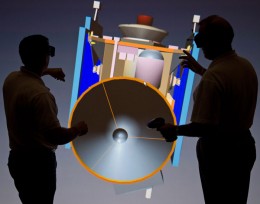((Contributed by Timothy R. Gaffney))

This wall-size 3D visualization system is among the capabilities the Wright State Research Institute will demonstrate Tuesday, Oct. 18, at the TechNet-Aero Conference and Trade Show in the Dayton Convention Center. The Research Institute is a part of Wright State University.
Members of the Department of Defense and industry attending the aerospace conference and trade show TechNet-Aero this week will get a glimpse of the aerospace and human performance research capabilities of the Wright State Research Institute, ranging from neuromedical imaging to advanced visualization to unmanned aerial vehicle (UAV) testing and evaluation.
TechNet-Aero is the new name of the former InfoTech, produced by the Dayton-Wright Chapter of the Armed Forces Communications and Electronics Association (AFCEA) and held in the Dayton Convention Center.
The Wright State Research Institute will take center stage in the new, Dell Inc.-sponsored Discovery and Innovation Range at the opening of TechNet-Aero’s trade show on Tuesday, Oct. 18. It will present live demonstrations of its use-inspired research, as well as sponsored research programs, that have applications for aerospace, national defense and human performance.
“The Wright State Research Institute enjoys significant technical expertise in areas in which military and industrial organizations are facing some of their most complex problems,” including human performance, data management and analysis, modeling and simulation and air vehicles, said Ryan Fendley, director of the Wright State Research Institute. “Whether it’s research supporting the needs of the warfighter, or creating data analysis tools, we can develop solutions to these problems for our sponsors.”
Demonstrations will include the Wright State Research Institute’s portable, stereo 3-D visualization tool from one of the most advanced visualization and presentation environments in the country. The Wright State Research Institute helps industry and researchers make use of advanced immersive visualization to aid in the modeling, interaction and presentation of complex ideas, designs and processes.
“The stereoscopic and immersive 3-D environments at our facility, combined with our advanced data expertise, can be leveraged to solve human performance problems and perform data analysis,” said Terry Rapoch, chief technologist at the Wright State Research Institute.
Researchers will demonstrate six different technologies and aerospace projects throughout the day, with 15-minute presentations on each according to the following schedule:
11:00 a.m. – 3-D Visualization Tools: Using a powerful, portable 3D projector and a wall-size screen, the Wright State Research Institute will demonstrate how planar images are rendered into 3-D and how data can be converted into visualizations to assist in decision making.
Noon – Air Vehicles: Wright State Research Institute engineers who conduct flight testing for single operator control of multiple UAVs will demonstrate the Vigilant Spirit Ground Station and how it works with two companion aircraft, the Unicorn and Bat-3.
1:30 p.m. – Modeling, Simulation and Data Analysis: Using the Simajin simulation tool and business intelligence software, the Wright State Research Institute took detailed infrastructure data regarding population, medical facilities and transportation resources to create the Special Needs Assessment and Planning (SNAP) environment, a planning tool for emergency managers for facilitating the analysis of the emergency response to a disaster. The tool provides planners with real data in their communities on special needs populations and assists them in delivering on a federal mandate regarding sheltering functional needs populations.
2:00 p.m. – Information Technology: The Wright State Research Institute’s Java Generation Tool (JGT) develops software systems rapidly and predictably, cutting software development time in half. The tool can help organizations speed up their legacy transformation projects.
3:00 p.m. – Image Processing and Human State Assessment: Through the use of thermal imaging as well as feature extraction, segmentation and registration, Wright State Research Institute researchers are using biometric image processing to assist in the identification of behavioral intent of human subjects. This technology might one day improve human performance in demanding situations. Wright State Research Institute researchers have also developed a hybrid system that searches images by keywords similar to the current Google image search, coupling the annotation-based image retrieval (ABIR) and the content-based image retrieval (CBIR) algorithms with human input. This new approach has important applications for national defense—searching growing streams of surveillance imagery—and for health care, helping medical doctors analyze medical images.
4:00 p.m. – Neuromedical Imaging: Image capture and processing techniques in neuromedical imaging demonstrate how using EEG, functional magnetic resonance imaging and other sources enable evaluation, training and understanding of the human brain.
TechNet-Aero is the Dayton region’s premier aerospace technology conference and trade show. Organizers expect more than 1,500 military, government and industry members to attend it.
The Wright State Research Institute provides a gateway to university capabilities, researchers, scientists and staff. It executes a robust research program in human performance, providing federal agencies and industrial organizations around the country with easy access to the human performance expertise they need. With a focus on applied research and services, the Wright State Research Institute applies emerging technologies to difficult problems facing our industry and government sponsors, and its use-inspired research drives the technological state of the art.
For more information about TechNet-Aero, go to www.afcea-technetaero.org
For more information about the Wright State Research Institute, go to wsri.wright.edu

 Wright State introduces seven new or restructured undergraduate degrees
Wright State introduces seven new or restructured undergraduate degrees  Wright State ranked among top universities worldwide for second consecutive year
Wright State ranked among top universities worldwide for second consecutive year  Wright State to host march honoring military personnel and first responders
Wright State to host march honoring military personnel and first responders  A chance to shine
A chance to shine  Warm greeting
Warm greeting 